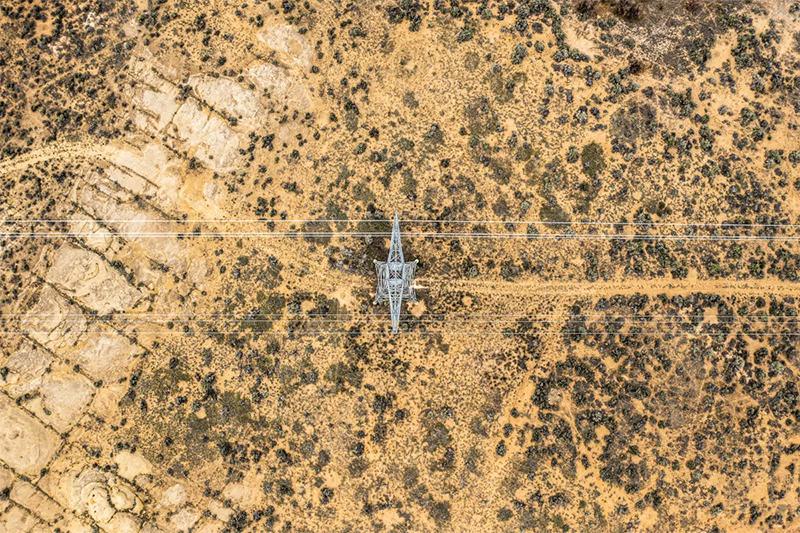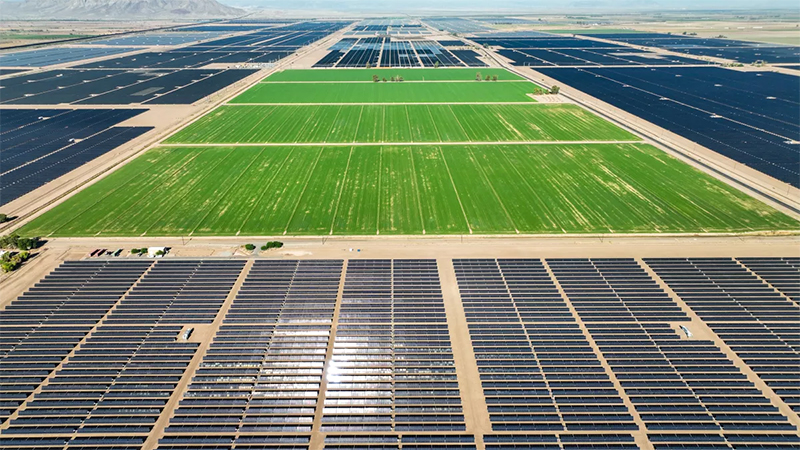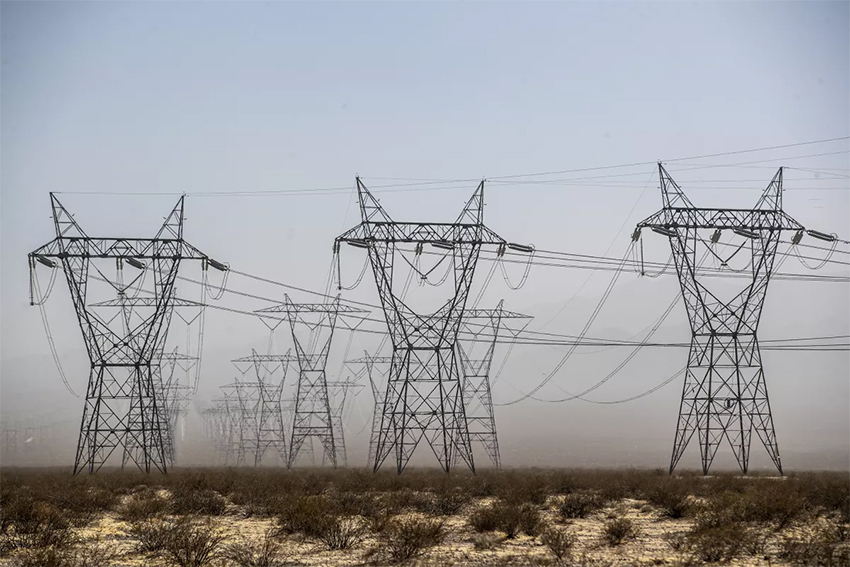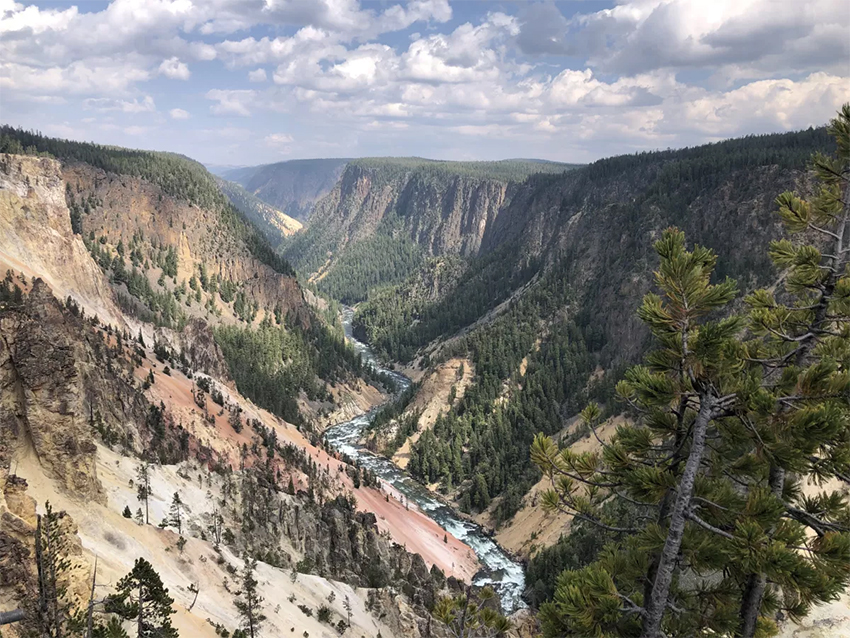|

06 April
2023
By
SAMMY ROTH
- STAFF
WRITER
California's race against time to build power lines

This
story originally published in Boiling Point, a weekly newsletter about
climate change and the environment. Sign
up here to
get it in your inbox.
Want to live in a world where heat waves stop getting hotter,
wildfires stop getting bigger, water shortages stop getting more
severe and storms stop getting more destructive?
Then you should probably cozy up to electric power lines.
Solar panels and wind turbines take up a lot of the oxygen in
conversations about clean energy solutions. But for solar and wind to
supply ever-larger amounts of electricity — and replace the coal, oil
and natural gas cooking the planet — the United States will need a lot
more transmission lines, to carry renewable electricity from the
nation’s sunniest, windiest places to the big cities that suck up huge
amounts of power.
How significant is the need for new transmission? The REPEAT Project,
which is led by Princeton University researchers, reported
last year that 80% of the potential cuts in carbon pollution made
possible by the Inflation Reduction Act — the climate bill signed by
President Biden — could be lost if the U.S. fails to accelerate the
build-out of its electric grid.
There’s a similar reality at work in California, where state law
requires 90% clean energy by 2035 and 100% by 2045 — on a power grid
big enough and robust enough to support tens of millions of electric
cars, home heating systems and stoves.
A new report puts some numbers to the urgent need to build power lines
— and upgrade existing wires.
Over the next decade, the California Independent System Operator says
in the draft
report, the state should spend at least $7.5 billion on
transmission projects that would support renewable energy growth. Plus
another $1.8 billion on projects that would help prevent blackouts —
which are getting more
difficult to avoid as rising temperatures drive up demand for air
conditioning, and as the power grid becomes increasingly reliant on
solar panels that stop generating electricity after dark.

Power lines run through California’s
Imperial Valley, an agricultural region that also produces growing
amounts of solar energy.
(Robert Gauthier / Los Angeles Times)
Those new and upgraded power lines would be paid for largely by
customers of the state’s major monopoly utility companies: Southern
California Edison, Pacific Gas & Electric and San Diego Gas &
Electric. The billions of dollars in expenditures would add to utility
bills at a time when electricity costs are already rising
rapidly, straining cash-strapped families and making it less
likely that Californians will want to replace their fossil-fueled
cars, furnaces and stoves with electric alternatives.
Nobody said solving the climate crisis would be easy. But getting the
ball rolling on new power lines has been especially tough. Hardly
anybody wants to pay for them, even if they’ll save money — and lives
— in the long run. And getting permission to string wires over long
distances — with some routes traversing multiple
states and hundreds of landowners — can take a decade or more.
So what kinds of tricks might California have up its sleeve? Here are
four things to know.
1. This isn’t a new problem
It’s been clear for at least a decade that new and upgraded
power lines would be needed to facilitate construction of more solar
farms in California’s Central Valley, geothermal
plants by the Salton Sea and floating
wind farms off the coast.
But for the most part, those projects haven’t gotten built. Inertia
has prevailed over action.
When I asked Elliot Mainzer — chief executive of the California
Independent System Operator, which oversees the electric grid —
whether anything’s really going to change after his agency’s report,
he offered several reasons for optimism.
First, he said, the system operator reached a new
agreement in December with the state’s Public Utilities Commission
and Energy Commission, the other entities responsible for planning and
approving power grid projects. It should lead to closer coordination
among the agencies as they provide direction to companies proposing
power plants and transmission lines, he said.
Second, the system operator is reworking
its process for responding to “interconnection requests,” in which
energy developers apply to hook up their power projects to the grid.
Right now, there are so many requests — many of them for plants
unlikely to ever get built — that the agency is moving far too slowly
to study and approve badly needed solar and wind farms.
Better processes don’t always lead to better outcomes. But Mainzer
insists these are important steps.
“We’re trying to take any barriers off the table,” he said. “It’s a
big lift. But failure’s not an option.”
The draft report still needs to be approved by the system operator’s
board of governors. And even if the board signs off on the billions of
dollars in projects, the Public Utilities Commission still needs to
give them the OK, too — a much bigger lift.
2. We’re talking mind-boggling amounts of clean power

Some of the numbers in the new report are hard to wrap your head
around.
Right now, California has just over 80 gigawatts of electric
generating capacity. The system operator and other agencies envision
adding 70 gigawatts over the next decade — and an additional 50
gigawatts by 2045, the deadline for 100% clean energy.
So we’re talking about more than doubling the size of the power grid.
The transmission projects outlined in the report would enable 17
gigawatts of solar development, from the Central Valley to the Mojave
Desert to neighboring regions of Nevada and Arizona; eight gigawatts
of offshore wind; eight gigawatts of onshore wind, more than half of
it coming from Idaho, New Mexico and Wyoming; and at least a gigawatt
of geothermal energy.
Those facilities could dramatically reduce the need to burn natural
gas, which in 2021 supplied more
than one-third of the state’s electricity. But they wouldn’t
eliminate the need for gas plants, many of which are in low-income
communities of color burdened
by high levels of air pollution. Even with lots of new solar and
wind — and batteries — officials expect there will still be a need for
gas turbines that can be fired up on the hottest summer days, when
demand for air conditioning strains the power grid.
One transmission line not yet endorsed by the California Independent
System Operator could change that equation.
The report notes that the system operator has had discussions with the
L.A. Department of Water and Power — which runs its own independent
electric grid — about an undersea cable called the Pacific
Transmission Expansion. The proposed multibillion-dollar
power line would hug the California coast for 200 miles, with the
ability to carry offshore wind energy to the Los Angeles Basin and
potentially reduce the region’s reliance on a fleet of dirty — and at
least recently, expensive —
gas plants.
Will Los Angeles take the unusual step of partnering with other power
providers on the undersea cable, which could reduce costs to
ratepayers and help bring the project to fruition? Possibly. DWP
spokesperson Ellen Cheng told me via email that the utility has
identified the proposal as “an opportunity for collaboration with
neighboring electric utilities in the region.”
3. None of this will be cheap
The system operator estimates that the $9.3 billion in projects it’s
recommending would raise electricity costs by half a cent per
kilowatt-hour — a small fraction of the 26 cents, on average, that
homes served by SoCal Edison currently pay.
But with electricity bills forecast to keep rising for all sorts of
reasons — including utility investments to prevent
wildfire ignitions, the costs of which are passed along to
customers — lawmakers and regulators are justifiably wary of anything
that will add to the burden on low- and middle-income families. Even
power lines needed to confront the climate crisis.
“We’re trying to come out with the most efficient, cost-effective plan
we possibly can,” Mainzer said. “This is going to unleash a tremendous
amount of clean energy and help support reliability for the fourth-largest
economy in the world.”
Four of the most expensive transmission projects recommended by the
system operator — with an estimated cost of more than $5 billion
combined — will be put out for competitive bidding. That means rather
than Edison, PG&E or SDG&E being awarded the lucrative projects by
default, independent developers will have an opportunity to step in at
a lower cost.

Houston-based developer Grid United may submit a bid. Chief Executive
Michael Skelly — whose efforts to string electric lines from the
wind-rich Oklahoma Panhandle to Tennessee were the focus
of a book about the challenges of building transmission — told me
he thinks California will be able to actually move projects forward.
He praised the system operator for taking a proactive approach in its
new report, mapping out where specific power lines will be needed to
enable renewable energy growth.
“California is saying, ‘OK, y’all are ready. We’re here to receive you
with open arms,’” Skelly said.
Although competitive bidding could lower costs for some power lines,
it won’t address a key reason other transmission projects are so
expensive: guaranteed profit margins authorized by the Federal Energy
Regulatory Commission, which allow utilities such as Edison and PG&E
to charge customers not only for the costs of building a line, but
also a cut for their shareholders. Critics say the profits allowed by
the agency are far
too high, while utilities counter that they’re needed to reduce
financial risks.
When I asked Mainzer about the utility profit question, he told me he
doesn’t have “a major position on that.”
4. Getting permission to build is not easy
Two recent reports show just how hard it can be to build power lines
in California.
One, from the Clean Air Task Force, lays
out the arduous approval process at the Public Utilities
Commission, with environmental reviews required by the California
Environmental Quality Act that can take as long as four years. The other
report, from consulting firm GridLab and clean energy advocacy
group CEERT, notes that it took 12 years for Edison to finish a
project to bring thousands of megawatts of wind power from the
Tehachapi area in Kern County to the Los Angeles Basin.
The Public Utilities Commission process “is too cumbersome and takes
too long,” said V. John White, CEERT’s executive director. He thinks
the state’s Energy Commission ought to take over permitting from the
beleaguered utilities commission.
“We’ve got to make it go faster, better, cheaper,” White said.
Several bills proposed
in the Legislature could speed things up.
One of them, Senate Bill 420, from Sen. Josh Becker (D-Menlo Park),
would allow state officials to designate power line proposals as
“environmental leadership development projects.” That would require
environmental lawsuits designed to block those lines to be resolved
within 270 days. The legislation would also eliminate what Becker’s
office describes as “duplicative economic review” at the utilities
commission for transmission projects already deemed necessary by the
system operator.
Then there’s Senate Bill 619 from Sen. Steve Padilla (D-Chula Vista),
which would designate high-priority transmission lines for fast-track
state review. Plus Assembly Bill 914 from Assemblymember Laura
Friedman (D-Glendale), which would exempt some power line projects
from the California Environmental Quality Act if they would help the
state meet its climate goals.
“These projects are transformational for California,” White said. “We
can’t treat them as unimportant.”
Something’s got to give. Until then, here’s what’s happening around
the West:
TOP STORIES

A mysterious pale residue fell on the San Francisco Bay Area city of
Martinez the day after Thanksgiving. Turns out it was hazardous
material from the nearby oil refinery — so why weren’t residents told
sooner, and why is soil testing taking so long? My colleague Tony
Briscoe tried to answer
those questions. In another oil industry story, L.A. Times
columnist George Skelton took on Gov. Gavin Newsom’s recent victory
over Big Oil, writing that Newsom was able to push a possible profits
cap through the state Legislature by getting aggressively
engaged behind the scenes, which was unusual for the governor.
Skelton also explored his
own transformation on petroleum politics, explaining that his dad
worked in California’s booming oil fields in the 1920s — and today his
daughter is part of the Biden administration, where she helps fossil
fuel workers find clean energy jobs.
Can music inspire people to care about climate change? I
absolutely loved this
column and podcast from The Times’ Rosanna Xia, about efforts by
famed Southern California earthquake expert Lucy Jones to communicate
the dangers of global warming — and inspire action — through music.
Jones plays the viola da gamba, a cello-like instrument, and she
convened “a remarkable group of scientists, psychologists and
composers to figure out how to write music that would break through
the fears and human instincts usually stopping us from thinking about
the future of our planet,” Xia writes. I’d encourage you to read and
listen as Xia and Jones grapple with some of the big existential
questions of modern times, and explore how music might help.
California’s snowpack has more water than Lake Mead right now, with a
record 306% of average snow in the southern Sierra Nevada. Details
here from my colleagues Sean Greene and Hayley Smith. Stunning
satellite photos show the state’s abrupt
shift from dry to lush, and the sudden
change of scenery at San Luis Reservoir, which has gone from
mostly empty to nearly full. The benefits are being felt all over
California: Creeks flowing down from the Santa Monica Mountains are
bursting with life; oak woodlands that protect snowpack are on the
rebound; flooded wetlands are providing habitat for migratory birds;
there’s less air pollution than at any time since at least 1999. The
Times’ James Rainey wrote about the
joys of our winter bounty.
Many communities, though, are still reeling from recent storms. State
and federal officials are finally coming through for the farmworker
town of Pajaro after floods displaced thousands of people, with
President Biden signing a major
disaster declaration. But it’s not clear how fast Pajaro’s broken
levee can be fixed, and whether it can be made better
than before, The Times’ Susanne Rust reports. First responders in
Pajaro are doing their best to communicate crucial info to evacuees —
many of them Indigenous Mexican farmworkers who
speak Mixteco, Ruben Vives and Melissa Gomez write. In the San
Joaquin Valley, residents worry that runoff from dairies, poultry
farms and a sewage facility could pollute
groundwater supplies if melting snow brings more floods, Brennon
Dixson and Rust report — and many other parts of the state face their
own spring and summer flood concerns. In Los Angeles County,
meanwhile, residents of two tiny lakeside communities don’t want a
flood control district, which they see as too much government — but
they definitely need
help with climate whiplash, Louis Sahagún writes.
POLITICAL CLIMATE

In a major new initiative to protect public lands, the U.S. Bureau of
Land Management plans to measure the health of all 245 million acres
it oversees, designate more protected areas and lease out land for
conservation to offset the impacts of energy development. Here’s
the story from Scott Streater at E&E News, who describes a mixed
reaction from environmentalists, with some praising the plan from
Interior Secretary Deb Haaland and others calling it wildly
insufficient. In Nevada, meanwhile, conservationists say the Biden
administration has failed to shut down speculative oil and gas leasing as
required by the Inflation Reduction Act, per Claire Carlson at the
Nevada Independent. And in Alaska, groups challenging Biden’s decision
to approve the Willow oil project lost
their first court battle to pause construction, Becky Bohrer
reports for the Associated Press.
California regulators may approve an exemption to the state’s clean
vehicle rules that would allow 10,000 natural gas-fueled garbage
trucks to keep spewing pollution until 2042. “We’re basically
carving out exemptions because of political protest from people who
made bad investments,” Sasan Saadat, a policy analyst at the
environmental group Earthjustice, told
the Sacramento Bee’s Ari Plachta. “You’ll end up in this absurd
situation where vehicles ready to go electric at a fast pace will be
put on the slowest timetable in communities most overdue for relief.”
At the federal level, new rules unveiled by Biden administration
officials will make many electric passenger cars ineligible
for tax credits, the New York Times’ Ana Swanson and Jack Ewing
report — a result of the Inflation Reduction Act, which largely limits
the credits to cars with American-made parts.
THE ENERGY TRANSITION
A new study links drought and heat waves to air pollution spikes in
low-income and nonwhite communities, because there are more
fossil-fueled power plants firing up to supply electricity for air
conditioning. Part of the problem is reduced
hydroelectricity production, which increases the need for coal and
gas plants, as my colleague Dorany Pineda reports. Speaking of which,
efforts to tear down four dams on the Pacific Northwest’s Snake River
— which would help struggling salmon populations but result in less
hydropower output — are probably dead in the water, at least for now,
with Republicans who oppose dam removal in charge of the House of
Representatives. Details
here from Crosscut’s Nicholas K. Geranios.
Jim Bridger, the West’s largest coal plant, will stop burning the
dirtiest fossil fuel in 2030, seven years ahead of schedule — but
another coal unit elsewhere in Wyoming will stay online 12 years later
than expected. That’s the timeline laid out in the latest resource
plan from Rocky Mountain Power, part of Warren Buffett’s PacifiCorp
electric company. The Casper Star-Tribune’s Nicole Pollack wrote
about the plan, noting that PacifiCorp wants to nearly quadruple
its wind and solar capacity. In Montana, another coal plant looks like
it will unexpectedly
survive past 2025, with two Washington utilities agreeing to sell
their shares to owners who hope to keep the thing running, Benjamin
Storrow reports for E&E News. The Biden administration, meanwhile,
just rolled out new
incentives to support renewable energy development in coal
communities, per E&E News’ Robin Bravender.
Amazon is so committed to its “climate pledge” of net-zero carbon
pollution by 2040 that the company paid to have the Seattle Kraken
hockey team’s arena christened the Climate Pledge Arena. But in
Oregon, Amazon helped
defeat a bill that would have required its growing fleet of data
centers to eliminate their emissions by 2040 — yes, the same year the
company has publicly committed to, the Washington Post’s Caroline
O’Donovan reports. An Amazon spokesperson told the Post that the bill
in question “does not address the build-out of electric infrastructure
that is needed to bring more clean energy to the grid.”
AROUND THE WEST

A massive bison hunt just took place outside Yellowstone, with members
of eight Native American tribes killing 1,150 buffalo and rounding up
hundreds more as they left the national park. The hunt is meant to
protect cattle from an infectious disease common among bison — and
help Indigenous tribes restore their historical connection with the
animal — but the larger-than-usual number of creatures killed this
time around has stirred
up opposition, Jim Robbins reports for the New York Times. I was
especially struck by Michael Hanson’s intimate photos of Native
Americans harvesting and processing bison remains.
North America’s largest carbon capture machine was unveiled in a
nondescript warehouse district in Colorado. “The shed-size machine
draws carbon dioxide out of ambient air for reuse in industrial
products or sequestration in underground caverns, a technology that
could be replicated thousands of times around the globe to combat the
buildup of CO2 from a century of burning fossil fuels,” Michael Booth writes
for the Colorado Sun. Although scientists say we need to remove
large amounts of carbon from the atmosphere, some activists worry
fossil fuel companies will use the technology as an excuse to keep
polluting.
Former California Gov. Jerry Brown now has a beetle named after him. UC
Berkeley researchers discovered the “Bembidion brownorum” species on the
off-grid Colusa County ranch that Brown shares with his wife,
Anne, SFGate’s Alec Regimbal reports. The former governor had
previously declined to have just about anything named after him, but
he relented in this case. “Suffice it to say he derives a good deal of
satisfaction that a humble beetle discovered at the Mountain House
will help his legacy live on,” Brown biographer Miriam Pawel writes in
an L.A.
Times opinion piece.
ONE MORE THING
In last week’s newsletter, I linked to a new poll
from climate news startup Heatmap finding that 79% of Americans
believe moving slowly on renewable energy to protect wildlife and
natural landscapes from solar and wind farms is more important than
moving quickly on renewable energy to reduce climate pollution.
This week, climate journalist Emily Atkin published a critique of that
poll in her Heated newsletter. She spoke with experts — and a U.S.
senator — who described “renewable energy vs. wildlife conservation”
as a false choice, and said the poll’s wording failed to make clear
just how dangerous global warming is for animals and ecosystems.
As a reporter who has spent most of the last decade writing about
conflicts between clean energy and conservation, I found the Heatmap
poll interesting and worthwhile. Much as journalists should strive to
foster a thoughtful, nuanced debate aimed at bringing about climate
solutions — which I have tried very hard to do! — it’s also useful to
know where the public stands, which isn’t always based on much nuance.
The Heatmap poll offers a valuable glimpse at public opinion.
I also agree that the “renewable energy vs. conservation” question was
too simplistic, and left out important information. I’m super curious
what people would have said if they’d been told or reminded that
climate change is bad for wildlife.
So everybody is trying their best, and now we can move forward. How’s
that for a hot take?
Green Play Ammonia™, Yielder® NFuel Energy.
Spokane, Washington. 99212
www.exactrix.com
509 995 1879 cell, Pacific.
exactrix@exactrix.com
|